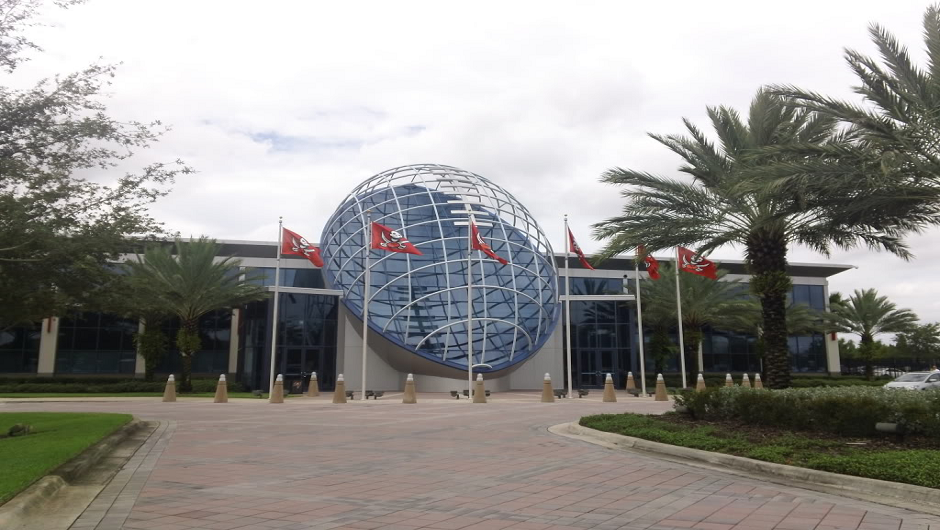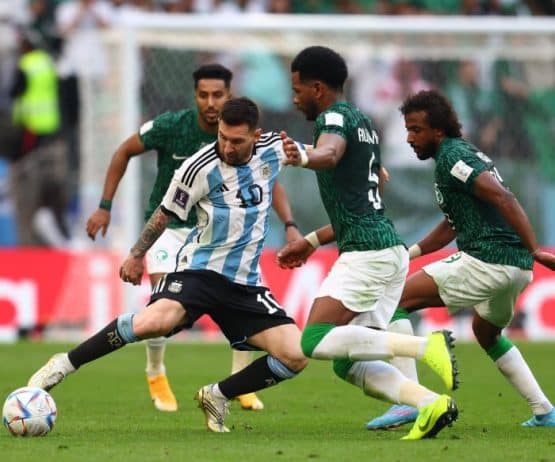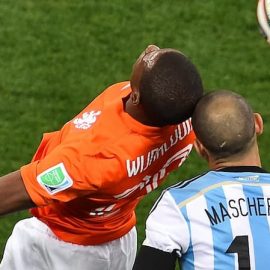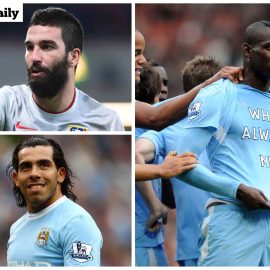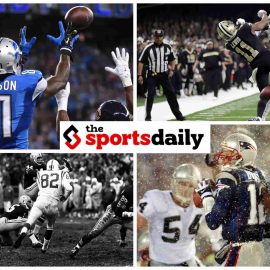I’ll always remember my first, “Wow, I’m really part of an NFL front office moment.”
I sat in General Manager Mark Dominik’s office, surrounded by all of the important decision-makers for the Tampa Bay Buccaneers. It was shortly after the 2011 lock… er, I mean, “work stoppage” had ended. Training camp was now less than 5 days away and we had to do 3 months of work in that timespan. The proverbial crap was hitting the fan.
I looked around the room in awe of the people I was receiving orders from and the environment I was in. I was acutely aware that I was in a position that any NFL fan dreamed of – sitting in a room being able to listen to decisions being made and the discussions that preceded them.
I learned quickly that an NFL front office is far removed from the typical office environment that most Americans experience on a day-to-day basis.
Structure
Because there are 32 NFL teams that operate as 32 completely separate businesses, I can’t speak for all of them, but I can give you the generalities of the league.
In the NFL, organizations are divided into two entities: the “football” side and the “business” side.
The football portion of the organization consisted of coaches, personnel, scouts, trainers, strength and conditioning, football technology and video, equipment, and typically football operations. Sometimes public relations would also fall on the football side.
On the business side, it was like most normal corporations – marketing, accounting, sales, creative production, and human relations. For us, operations and public relations both fell on the business side of the divide. As far as I know, Tampa is the only team in the league that organizes it that way.
The two sides of the organization may interact excessively or almost not at all, depending on departments. My position fit squarely in the middle as I managed “business side” tasks that affected the daily and weekly preparation of the team substantially. Even though my hierarchy of bosses fell on the business side of the team, I interacted with the coaches and general manager on a daily basis.
Because of the structure of NFL teams, the dynamics of the interactions of departments are unique. The football side was only to be bothered when absolutely necessary. Everyone on the business side knew that the coaches had long days and nights and no one was to bother them unless it was an absolute necessity. The players’ area, especially the locker room, was off limits to most of the organization. This is a smart rule that keeps distractions at a minimum. Some teams even have the football side in a separate building from the business side to further eliminate distractions.
The coaches didn’t take the same approach with the business side. They loved to come to our side of the building and interact with the employees. Most of our coaches were very personable and easy to get along with, and sought out conversations or went out of their way to be polite to “the other side.” Most seemed to understand that the business side was a type of support staff and that their work allowed the coaches to do the jobs that they loved to do.
Decision Making
NFL teams don’t go by the same thought processes as fans or media. Each team makes it’s own decisions, but for the most part they all follow the same thought processes.
When fans watch the game on television, they see the on-field product and that leads them to think only in terms of the depthless presentation that graces their screen. For fans, decisions are very clean and easily made. “Player X played well and he should play more next week.” The problem with this type of thinking is that it’s very superficial in terms of the game and doesn’t encapsulate all of the elements that go into the tiny decisions that are made every week/day/play.
Team executives agonize over most decisions. Some are easy, but most are complicated dilemmas that involve several layers of analysis that leads a team to a specific resolution of an issue. The NFL is a very volatile business where football staffs have an infinitesimal amount of job security. One or two bad decisions by one member of a staff can cost the entire group their jobs.
Fair or not, that’s the way it is. That leads organizations to tend to think in parallel ways. They think in inclusive concepts that consider all possibilities and details. Coaches tend to think in terms of present situations while personnel staffs tend to balance them out with an emphasis on building for the future. The dissension is useful as it helps to contrast and fill gaps that the other side may not have considered.
When juxtaposing this viewpoint against a fan’s perspective, we can understand how the two sides may differ in opinion. A person whose job isn’t on the line is much more likely to make drastic changes to an organization based solely on performance and not on projections or potential. Fans want immediate gratification – win now at all costs.
Teams want to win now, but they also can’t mortgage the future for the present. A good example is the Jay Cutler and Josh McCown situation. Bears’ head coach Marc Trestman was always going to return Jay Cutler to the starting quarterback position when he was healthy enough to do so. McCown was playing great but Cutler is a much more physically talented player who gives the team a better chance to win. The Bears are willing to live with the unstable decision making of Cutler because his abilities presented them with more options on the field. The Bears also have to figure out if Cutler is their quarterback of the future or if it’s time to move on. McCown is older and less talented and that means that excludes him as the answer for the future. All of these aspects factor into the team re-instating Cutler as the starter, no matter how well McCown was playing. But fans were focused on the superficial “now.” McCown seemed to be putting up better statistics than Cutler had before his injury. That is all that fans needed to see to have a 34-year-old McCown supplant a 30-year-old Cutler as the franchise quarterback.
Teams also don’t think in terms of statistics the way that the ancillary fan does. The mainstream compilation statistics – yards, touchdowns, completion percentage, tackles, etc. – mean very little to decision makers in NFL organizations. They’re a factor, yes, but they’re a very small part of the picture. Teams think in terms of skill sets and the projection of those skill sets into each team’s own system. Eventually, if the results just aren’t showing then a team will give up on it’s evaluation of a player’s skill set, but it takes a significant lack of results for that to happen.
In a recent draft discussion, someone said, “I don’t understand why you’d draft a QB (Bridgewater) in what is essentially the Big East over Manziel who has beaten Alabama.” While that’s an interesting point, it’s simply not the logic that teams go by. It’s Bridgewater’s skills and abilities that teams will evaluate, not his singular wins. And no one understands that football is the epitome of a team sport better than the people in NFL organizations building the rosters. They won’t say, “Manziel beat Alabama.” Instead they’ll say, “Texas A&M beat Alabama, and how did Manziel factor into that?” The same goes for every player in college.
There are many ways in which teams think different than the massive fan base that cheers on the NFL every weekend. It’s important to tap into that method of thinking so that fans can understand the processes that lead NFL front office to certain decisions. This way, instead of shouting, “You’re an idiot! Only a moron would call that play!” fans might stop and think, “Why would they call that play?”
Dealing With Adversity
NFL teams, media, and fans are bi-polar. After every win, people associated with the team – both inside and outside – feel like they’re capable of winning the Super Bowl. After every loss, a mild form of depression sets in with the overwhelming thought that “if we continue to play like that, we won’t win another game.”
As good or bad as it is for fans after a win or a loss, that feeling can be exponentially exaggerated inside the building. It takes strong leadership to be able to stabilize those feelings and keep everyone balanced out in their confidence or despair. It’s tough because when people’s jobs are on the line the effect can snowball. During the Bucs’ 10-game losing streak in 2011, there were weeks where I wanted to get out of the office as much as possible because the atmosphere felt so dire.
I remember poking my head into the coaches’ office in the visitor’s locker room after a win and letting the coaches in the room know that we had 10 minutes until the busses were ready to leave the stadium to go to the airport for the flight home. The coaches were appreciative and invited me in and wanted to talk football, but because I was busy I wasn’t able to. The very next week, after a loss, I poked my head in for the same reason and all I received was, “Get the f— out of here!”
Adversity is paramount every week in the NFL. Whether it’s on the field or in the offices, there are always fires to be put out and problems to be solved. When friends asked what I did for the Buccaneers, I would tell them “Operations,” which would always be followed with, “What exactly does that mean?” I was a problem solver. I planned out weeks in advance for the team schedules and daily operations and then I solved the problems when things inevitably changed.
Sometimes a torrential downpour was on its way and looked to hit right at practice time. We had to practice one way or another. I’d call the Tropicana Field contact and see if the field was available while simultaneously getting busses to the facility to transport the team, equipment, and staff. Sometimes the team did walk-thrus in hotel ballrooms because fields weren’t available. From finding a black barber in London to finding a player who missed the team bus in an away city and then getting him to the locker room in time to dress for the game, my job was all about problem solving and dealing with adversity.
Every team and organization has to deal with adversity. Learning to handle bad breaks or setbacks and then efficiently dispose of them can help set the best apart from the rest.
That was the best lesson I learned from an NFL front office.
Add The Sports Daily to your Google News Feed!
